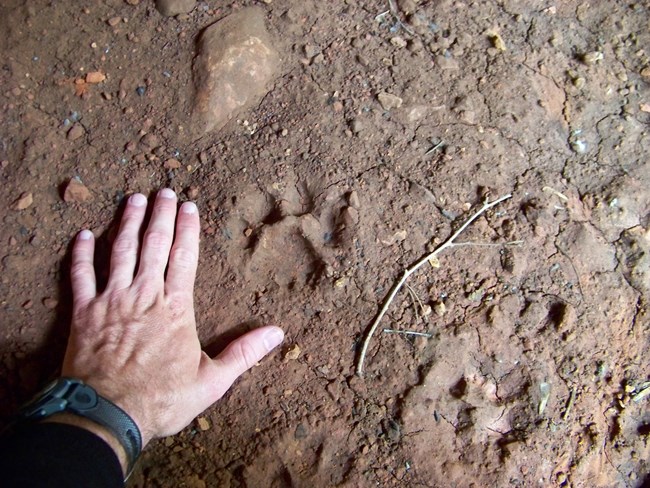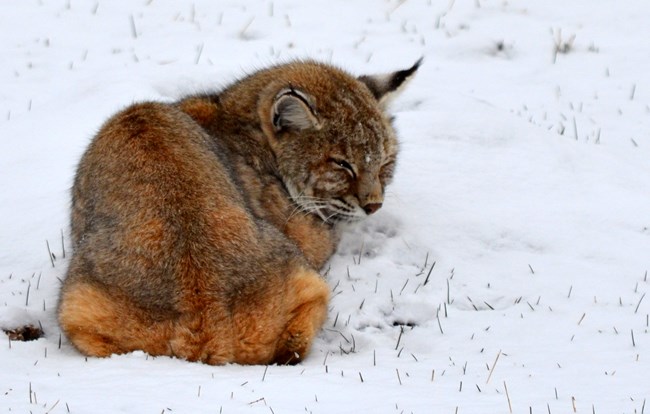Last updated: July 30, 2024
Article
Wind Cave Felines

NPS Photo

NPS Photo / Duane Weber
Mountain Lion
Cougar. Puma. Panther. Catamount. Mountain lion. These are some of the many names used to refer to Wind Cave's largest predator. Mountain lions are an elusive park visitor but are found throughout the Black Hills. Cats from the Black Hills (usually males) will sometimes travel east and have been found as far away as Tennessee. No more than three or four cats are thought to come into the park.Mountain lions are uniformly brown with a light belly and have a long, black-tipped tail. Cubs and young cats have spots that fade until they are about two years old. Adult males are larger and can weigh over 180 pounds. Deer are the mountain lion's favorite food, but they will also prey on elk, porcupines, and small mammals. After a successful hunt, they will cover their kill with grass and brush and return to feed on it for several days. Exceptionally agile, they can leap forward as much as 40 feet and climb a 12 foot high fence. This means they have no problem getting over the park's border fence.
Sometimes called screamers, mountain lions make a variety of sounds including growls, screams, chirps, and meows. Though they are the largest cat that can purr, they cannot roar like tigers or African lions. Cubs will stay with their mother for about two years before dispersing to find their own territory.
Mountain Lion Safety
Although mountain lion sightings are very rare, be proactive to reduce the risk of a conflict:
- Do not jog or hike alone. Go in groups with adults supervising children.
-
Keep children close to you. Do not allow children to play along creek beds, in heavy vegetation, or alone at dawn or dusk. When hiking with children, watch them closely and never let them run ahead of you.
If you encounter a lion, remember the goals are to convince it that you are not prey and that you may be dangerous. Follow these safety tips:
-
Do not approach a lion. Most mountain lions will try to avoid a confrontation. Give them a way to escape.
-
Do not run from a lion. Running may trigger a mountain lion's instinct to chase. Instead, stand and face the animal. Make eye contact. If you have small children with you, pick them up if possible so that they don't panic and run. Although it may be awkward, pick them up without bending over or turning away from the mountain lion.
-
Do not crouch down or bend over. A human standing up is just not the right shape for a lion's prey. Conversely, a person squatting or bending over resembles a four-legged prey animal. In mountain lion country, avoid squatting, crouching or bending over, even when picking up children.
-
Do all you can to appear larger. Raise your arms. Open your jacket if you are wearing one. Again, pick up small children. Throw stones, branches, or whatever you can reach without crouching or turning your back. Wave your arms slowly and speak firmly in a loud voice. The idea is to convince the mountain lion that you are not prey and that you may be a danger to it.
-
Fight back if attacked. People have fought back successfully with rocks, sticks, caps, jackets, garden tools, and their bare hands. Since a mountain lion usually tries to bite the head or neck, try to remain standing and face the attacking animal.

NPS Photo / Kim Acker
Bobcat
Of the park's two cat species, the bobcat is the smallest, weighing 15-20 pounds on average. Though they can be mistaken for young mountain lion cubs, the bobcat has a much shorter, stumpy tail. They range from gray to a light brown and usually have some spots, and have short tufts on the tips of their ears.Bobcats are most active in late evening and early morning and prefer forested habitats, but are found anywhere in the park. They have a large diet and prey on a variety of animals, especially rabbits, birds, prairie dogs, and other rodents. Adult bobcats can take down prey up to eight times their own size!
Like mountain lions, bobcats have defined territories and females raise their young on their own. Kittens will stay with their mother for up to one year as they learn to hunt and fend for themselves. Bobcats have been known to move out of areas with frequent mountain lion activity.
